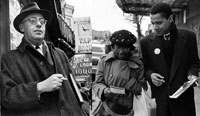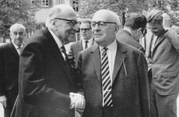Ah, the belief in the Illuminati.
The American Spectator :
Saul Alinsky Takes the White House
Rules for Radicals
By Saul Alinsky - 1971
7. Tactics
"Tactics are those conscious deliberate acts by which human beings live with each other and deal with the world around them. ... Here our concern is with the tactic of taking; how the Have-Nots can take power away from the Haves." p.126
Always remember the first rule of power tactics (pps.127-134):
1. "Power is not only what you have, but what the enemy thinks you have."
2. "Never go outside the expertise of your people. When an action or tactic is outside the experience of the people, the result is confusion, fear and retreat.... [and] the collapse of communication.
3. "Whenever possible, go outside the expertise of the enemy. Look for ways to increase insecurity, anxiety and uncertainty. (This happens all the time. Watch how many organizations under attack are blind-sided by seemingly irrelevant arguments that they are then forced to address.)
4. "Make the enemy live up to its own book of rules. You can kill them with this, for they can no more obey their own rules than the Christian church can live up to Christianity."
5. "Ridicule is man's most potent weapon. It is almost impossible to counteract ridicule. Also it infuriates the opposition, which then reacts to your advantage."
6. "A good tactic is one your people enjoy."
7. "A tactic that drags on too long becomes a drag. Man can sustain militant interest in any issue for only a limited time...."
8. "Keep the pressure on, with different tactics and actions, and utilize all events of the period for your purpose."
9. "The threat is usually more terrifying than the thing itself."
10. "The major premise for tactics is the development of operations that will maintain a constant pressure upon the opposition. It is this unceasing pressure that results in the reactions from the opposition that are essential for the success of the campaign."
11. "If you push a negative hard and deep enough, it will break through into its counterside... every positive has its negative."
12. "The price of a successful attack is a constructive alternative."
13. Pick the target, freeze it, personalize it, and polarize it. In conflict tactics there are certain rules that [should be regarded] as universalities. One is that the opposition must be singled out as the target and 'frozen.'...
"...any target can always say, 'Why do you center on me when there are others to blame as well?' When your 'freeze the target,' you disregard these [rational but distracting] arguments.... Then, as you zero in and freeze your target and carry out your attack, all the 'others' come out of the woodwork very soon. They become visible by their support of the target...'
"One acts decisively only in the conviction that all the angels are on one side and all the devils on the other." (pps.127-134)
Alinsky's Rules for Radicals: "Known as the 'father of modern American radicalism,' Saul D. Alinsky (1909-1972) developed strategies and tactics that take the enormous, unfocused emotional energy of grassroots groups and transform it into effective anti-government and anti-corporate activism. ... Some of these rules are ruthless, but they work."
http://www.crossroad.to/Quotes/communism/alinsky.htm
~
Saul Alinsky’s son: “Obama learned his lesson well”
Judi McLeod Tuesday, September 2, 2008
In Artful Dodger style, Barack Obama, plays down his mentorship with Communist author Saul Alinsky. But Alinsky’s son, L. David Alinsky, credits Obama for “learning his lesson well” from the Communist guru.
Indeed, Alinsky Jr. who credits his late father for the success of last week’s Democratic National Convention, may have done something that Obama’s detractors couldn’t: blown the cover on the presidential hopeful’s communist leanings....
....“Alinsky considered himself a realist above all, the ultimate pragmatist.” (American Thinker, Aug. 30, 2008). “As a confirmed atheist, Alinsky believed that the here and now is all there is, and therefore had no qualms about assorted versions of morality in the pursuit of worldly power. He didn’t coddle his radical acolytes or encourage their bourgeois distinctions between good and evil when it came to transferring power from the Haves to the Have Nots. Alinsky saw the already formed church communities as being the perfect springboards for agitation and creating bonds for demanding goods and services.”
Obama followed the same path.
It is a fact that activist-cum senator Barack Hussein Obama started off his career as an activist with a position as a community organizer for the Developing Communities Project (DCP) of the Calumet Community Religious conference (CCRC) in Chicago. Both the CCRC and the DCP were built on the Alinsky model of community agitation, wherein paid organizers learned, in Alinsky’s own words, how to “rub raw the sores of discontent”.
Meanwhile L. David Alinsky, perhaps unwittingly put Obama into the proper perspective by stating without reservation: “Obama learned his lesson well.”
Saul Alinsky’s son: “Obama learned his lesson well”



